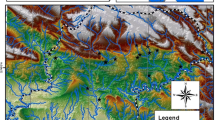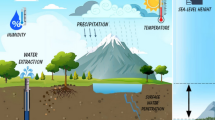Abstract
In this study, an automatic relevance determination-based Bayesian neural network (ARD-BNN) approach is employed combing hydro-geochemical and geo-electrical information to predict groundwater quality index (GWQI) of coastal Maharashtra, India. In the first step, to incorporate geo-electrical information for GWQI forward computation, the weight corresponding to true resistivity of the earth layer is estimated via ARD-BNN modelling using training sample generated for groundwater classification. In the second step, incorporating earth resistivity weight information, a total of 1500 training samples are created honouring World Health Organisation (WHO) guidelines for GWQI prediction. Prior to actual data analysis, we explored the algorithm on GWQI variable series assorted with different level of complex (red) noise to examine the bounds of network hyper-parameter. What distinguishes our approach from previous approach for ARD-BNN optimization is that we seek to develop a mechanism which allows specific weight estimation and provides insight into which hyper parameters and their bounds are appropriate to predict GWQI from noise intervened GWQI data. The model shows excellent performance between predicted and computed GWQI both in training (trn) and test (tst) data with Pearson’s correlation coefficient (rtrn ~ 0.91 and rtst ~ 0.90), root-mean-squared-error (RMSE) error (RMSEtrn ~ 1.2 and RMSEtst ~ 1.4), reduction of error (RE) (REtrn ~ 0.98 and REtst ~ 0.97), and index of agreement (IA) (IAtrn ~ 0.95 and IAtst ~ 0.93). Red noise analysis shows that the ARD-BNN model is robust up to the noise level of 20% in the input variable for GWQI prediction. The network adopted relevance analysis to indicate the relative importance of input parameter in the prediction of GWQI via ARD-BNN modelling which showed that chloride [Cl−], [pH], [HCO3 −] and sodium [Na+] are dominant while considering various simulations for characterizing the GWQI of coastal Maharashtra. The approach used here, could be useful in understanding the relative contribution and/or modelling pollution source in many other environmental applications.









Similar content being viewed by others
References
American Public Health Association (APHA) (1985) Standard methods for the examination of water and waste, 16th edn. Am. Public Health Assoc., Washington, DC, p 100
Bishop CM, (1995) Neural networks for pattern recognition. Oxford University Press, Oxford
Brown CH (1998) Applied multivariate statistics in geohydrology and related sciences. Springer, Berlin
Brown RM, McClelland NI, Deininger RA, Tozer RG, (1970) A water quality index: do we dare? Water Sew Works 117:339–343
Brown E, Skougstad MW, Fishmen MJ (1974) Methods for collection and analysis of water samples for dissolved minerals and gases. Govt. Printing Office, Washington
Calster BV, Timmerman D, Nabney IT, Valentin L, Testa AC, Holsbeke CV, Vergote I, Huffel SV (2008) Using Bayesian neural networks with ARD input selection to detect malignant ovarian masses prior to surgery. Neural Comput Appl 17:489–500
Central Ground Water Board (CGWB) (2009) Groundwater information Sindhudurg district Maharashtra by S.C. Paranjape, A report for Ministry of Water Resources, Government of India, p 16
Das A, Maiti S, Naidu S, Gupta G (2016) Estimation of spatial variability of aquifer parameters from geophysical methods: a case study of Sindhudurg district, Maharashtra, India. Stoch Environ Res Risk Assess. doi:10.1007/s00477-016-1317-4
Fetter CW (1988) Applied hydrogeology. Charles E. Merrill, Columbus
Gazzaz NM, Yusoff MK, Aris AZ, Juahir H, Ramli MF (2012) Artificial neural network modeling of the water quality index for Kinta River (Malaysia) using water quality variables as predictors. Mar Pollut Bull 64(11):2409–2420
Hem JD (1970) Study and interpretation of the chemical characteristicsof natural water. Water Supply Paper-1473, US Geological Survey, p 363
Hippert HS, Tylor JW (2010) An evaluation of Bayesian techniques for controlling model complexity and selecting inputs in a neural networks for short-term load forecasting. Neural Netw 23:386–395
Horton RK (1965) An index number system for rating water quality. J Water Pollut Control Fed 37:300–305
Krishna kumar S, Logeshkumaran A, Magesh NS, Godson PS, Chandrasekar N (2014) Hydro-geochemistry and application of water quality index (WQI) for groundwater quality assessment, Anna Nagar, part of Chennai city, Tamil Nadu, India. Appl Water Sci. doi:10.1007/s13201-014-0196-4
Lopez G, Batlles FJ, Tovar-Pescador J (2005) Selection of input parameters to model direct solar irradiance by using artificial neural networks. Energy 30:1675–1684
MacKay DJC (1992) A practical Bayesian framework for back-propagation net- works. Neural Comput 4(3):448–472
Magesh NS, Krishnakumar S, Chandrasekar N, Soundranayagam JP (2013) Groundwater quality assessment using WQI and GIS techniques, Dindigul district, Tamil Nadu, India. Arab J Geosci 6(11):4179–4189
Maiti S, Tiwari RK (2010) Neural network modeling and an uncertainty analysis in Bayesian framework: a case study from the KTB borehole site. J Geophys Res 115:B10208. doi:10.1029/2010JB000864
Maiti S, Erram VC, Gupta G, Tiwari RK (2012) ANN based inversion of DC resistivity data for groundwater exploration in hard rock terrain of western Maharashtra (India). J Hydrol 464–465:281–293. doi:10.1016/j.jhydrol.2012.07.020
Maiti S, Erram VC, Gupta G, Tiwari RK, Kulkarni UD, Sangpal RR (2013) Assessment of groundwater quality: a fusion of geochemical and geophysical information via Bayesian Neural Networks. Environ Monit Assess 185:3445–3465. doi:10.1007/s10661-012-2802-y
Moller MA (1993) Scaled conjugate gradient algorithm for fast supervised learning. Neural Netw 6:525–533
Nabney IT (2004) Netlab algorithms for pattern recognition. Springer, New York
Najah A, El-Shafie A, Karim OA, El-Shafie AH (2013) Application of artificial neural networks for water quality prediction. Neural Comput Appl 22:S187–S201. doi:10.1007/s00521-012-0940-3
Pradhan SK, Patnaik D, Rout SP (2001) Water quality index for the groundwater in and around a phosphatic fertilizer plant. Indian J Environ Prot 21:355–358
Ramakrishnaiah CR, Sadashivaiah C, Ranganna G (2009) Assessment of water quality index for the groundwater in Tumkur Taluk, Karnataka State, India. E J Chem 6(2):523–530
Sadat-Noori SM, Ebrahimi K, Liaghat AM (2014) Groundwater quality assessment using the water quality index and GIS in Saveh–Nobaran aquifer. Iran Environ Earth Sci 71:3827–3843
Sahu M, Mahapatra SS, Sahu HB (2011) Prediction of water quality index using neuro fuzzy inference system. Water Qual Expo Health 3:175–191
Schoeller H, (1959) Arid zone hydrology, recent developments. UNESCO, Paris
Schoeller H (1967) Methods and techniques of groundwater investigationand development. Water Resources Series-33. UNESCO, Paris
Singh AK, Mondal GC, Singh S, Singh PK, Singh TB, Tewary BK, Sinha A (2007) Aquatic geochemistry of dhanbad, Jharkhand: source evaluation and quality assessment. J Geol Soc India 69:1088–1102
Stigter TY, Ribeiro L, Carvalho Dill AMM (2006) Application of a groundwater quality index as an assessment and communication tool in agro-environmental policies-Two Portuguese case studies. J Hydrol 327:578–591. doi:10.1016/j.hydrol.2005.12.001
Todd DK (1959) Groundwater hydrology. Wiley, New York, pp 277–294
Vadiati M, Asghari-Moghaddam A, Nakhaei M, Adamowski J (2016) A fuzzy-logic based decision-making approach for identification of groundwater quality based on groundwater quality indices. J Environ Manag. doi:10.1016/j.jenvman.2016.09.082
Van der Bann M, Jutten C (2000) Neural networks in geophysical applications. Geophysics 65:1032–1047
Vasanthavigar M, Srinivassamoorthy K, Vijayaragavan K, Rajiv Ganthi R, Chidambaram S, Anandhan P, Manivannan R, Vasudevan S (2010) Application of water quality for ground water quality assessment: Thirumanimuttar Sub basin, Tamil Nadu, India. Environ Monit Assess 171:595–609
Wang D, Lu WZ (2006) Interval estimation of urban ozone level and selection of influential factors by employing automatic relevance determination model. Chemosphere 62:1600–1611
Willmott CJ (1981) On the validation of models. Phys Geogr 2:184–194
World Health Organization (WHO) (1984) Guideline of drinking quality. World Health Organization, Washington, DC, pp 333–335
Zou ZH, Wang H (2010) Adaptive neuro fuzzy inference system for classification of water quality status. J Environ Sci 22:1891–1896
Acknowledgements
Authors are thankful to the Director, IIT (ISM), Dhanbad and Director, IIG, Navi Mumbai for their kind permission to publish the work. AD is thankful to ISM JRF fellowship in which the some analysis work is done Partial financial benefit from the Ministry of Earth Sciences, Govt. of India, New Delhi, India, is also thankfully acknowledged (Grant no: MoES/P.O. (Geosci)/44/2015).
Author information
Authors and Affiliations
Corresponding author
Rights and permissions
About this article
Cite this article
Maiti, S., Das, A., Shah, R. et al. Application of automatic relevance determination model for groundwater quality index prediction by combining hydro-geochemical and geo-electrical data. Model. Earth Syst. Environ. 3, 1371–1382 (2017). https://doi.org/10.1007/s40808-017-0369-x
Received:
Accepted:
Published:
Issue Date:
DOI: https://doi.org/10.1007/s40808-017-0369-x




